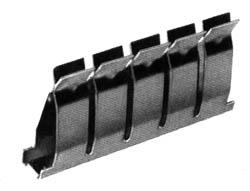A bread board is also known as a project board, It has got itself a place in every electronics hobbyist because of its "User Friendly" Nature, a bread board needs no soldering and already it is connected internally, lets see about it in detail.
This is how a bread board looks
A bread board is available in many shapes and sizes and has a facility to connect many boards as you like.
Connections in a Bread Board
NOTE: In some bread boards the top and bottom are not fully linked only 5 pins are linked.
Working
The heart of the solder-less breadboard is a small metal clip that looks like this:
The clip is made of nickel silver material which is reasonably conductive, reasonably springy, and reasonably corrosion resistant. Because each of the pairs of fingers is independent we can insert the end of a wire between any pair without reducing the tension in any of the other fingers. Hence each pair can hold a wire with maximum tension.
Using a Bread Board
- Before building a circuit, connect power to the red terminal. For a battery pack, connect the positive (+) from the battery pack to the red screw terminal. Since ground is a reference voltage, connect the negative (-) from the battery pack to the black screw.
- Unscrew the terminals and connect the battery pack, as described above. Screw the wire down firmly so that it doesn't move, but not so firmly that the wire is cut.
- If you are using a power supply, simply connect power to the red terminal on the breadboard with a banana plug to a banana plug cable. There will be a ground connection on the power supply that can be connected to the ground terminal.
- Once power and ground have been connected to the board, connect a wire, also known as a jumper wire, from the red terminal to the power bus (the red highlighted row). The wire should be just long enough to span the distance between the terminal and the bus.
- Take the wire and strip off � inch of insulation from both ends. Connect the ground to the blue highlighted bus. Make sure the wire is just long enough to span the distance between the black terminal and the bus.
- Strip off � inch from both ends and connect the ground bus to the black terminal. The breadboard is now ready to have a circuit built upon it.

This shows how a 380 ohm resistor and an LED are setup on a breadboard. When a 9 volt battery is attached the LED lights. Try replacing the resistor with a higher value such as a 680 ohm resistor. The resistance will be greater and the LED should shine less bright.









0 comments:
Post a Comment